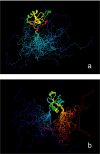Should I stay or should I go? Eukaryotic translation initiation factors 1 and 1A control start codon recognition
- PMID: 18593708
- PMCID: PMC2562056
- DOI: 10.1074/jbc.R800031200
Should I stay or should I go? Eukaryotic translation initiation factors 1 and 1A control start codon recognition
Abstract
Start codon selection is a key step in translation initiation as it sets the reading frame for decoding. Two eukaryotic initiation factors, eIF1 and eIF1A, are key actors in this process. Recent work has elucidated many details of the mechanisms these factors use to control start site selection. eIF1 prevents the irreversible GTP hydrolysis that commits the ribosome to initiation at a particular codon. eIF1A both promotes and inhibits commitment through the competing influences of its two unstructured termini. Both factors perform their tasks through a variety of interactions with other components of the initiation machinery, in many cases mediated by the unstructured regions of the two proteins.
Figures


Similar articles
-
Regulation of GTP hydrolysis prior to ribosomal AUG selection during eukaryotic translation initiation.EMBO J. 2005 Nov 2;24(21):3737-46. doi: 10.1038/sj.emboj.7600844. Epub 2005 Oct 13. EMBO J. 2005. PMID: 16222335 Free PMC article.
-
ABC50 mutants modify translation start codon selection.Biochem J. 2015 Apr 15;467(2):217-29. doi: 10.1042/BJ20141453. Biochem J. 2015. PMID: 25597744
-
β-Hairpin loop of eukaryotic initiation factor 1 (eIF1) mediates 40 S ribosome binding to regulate initiator tRNA(Met) recruitment and accuracy of AUG selection in vivo.J Biol Chem. 2013 Sep 20;288(38):27546-27562. doi: 10.1074/jbc.M113.498642. Epub 2013 Jul 26. J Biol Chem. 2013. PMID: 23893413 Free PMC article.
-
Structural Insights into the Mechanism of Scanning and Start Codon Recognition in Eukaryotic Translation Initiation.Trends Biochem Sci. 2017 Aug;42(8):589-611. doi: 10.1016/j.tibs.2017.03.004. Epub 2017 Apr 22. Trends Biochem Sci. 2017. PMID: 28442192 Review.
-
The scanning mechanism of eukaryotic translation initiation.Annu Rev Biochem. 2014;83:779-812. doi: 10.1146/annurev-biochem-060713-035802. Epub 2014 Jan 29. Annu Rev Biochem. 2014. PMID: 24499181 Review.
Cited by
-
Identification of evolutionarily conserved non-AUG-initiated N-terminal extensions in human coding sequences.Nucleic Acids Res. 2011 May;39(10):4220-34. doi: 10.1093/nar/gkr007. Epub 2011 Jan 25. Nucleic Acids Res. 2011. PMID: 21266472 Free PMC article.
-
Spermatogenic failure and the Y chromosome.Hum Genet. 2017 May;136(5):637-655. doi: 10.1007/s00439-017-1793-8. Epub 2017 Apr 29. Hum Genet. 2017. PMID: 28456834 Review.
-
eIF1 controls multiple steps in start codon recognition during eukaryotic translation initiation.J Mol Biol. 2009 Nov 27;394(2):268-85. doi: 10.1016/j.jmb.2009.09.017. Epub 2009 Sep 12. J Mol Biol. 2009. PMID: 19751744 Free PMC article.
-
Uncovering buffered pleiotropy: a genome-scale screen for mel-28 genetic interactors in Caenorhabditis elegans.G3 (Bethesda). 2014 Jan 10;4(1):185-96. doi: 10.1534/g3.113.008532. G3 (Bethesda). 2014. PMID: 24281427 Free PMC article.
-
Structural basis for translational control by the human 48S initiation complex.Nat Struct Mol Biol. 2025 Jan;32(1):62-72. doi: 10.1038/s41594-024-01378-4. Epub 2024 Sep 17. Nat Struct Mol Biol. 2025. PMID: 39289545 Free PMC article.
References
Publication types
MeSH terms
Substances
Grants and funding
LinkOut - more resources
Full Text Sources
Other Literature Sources

